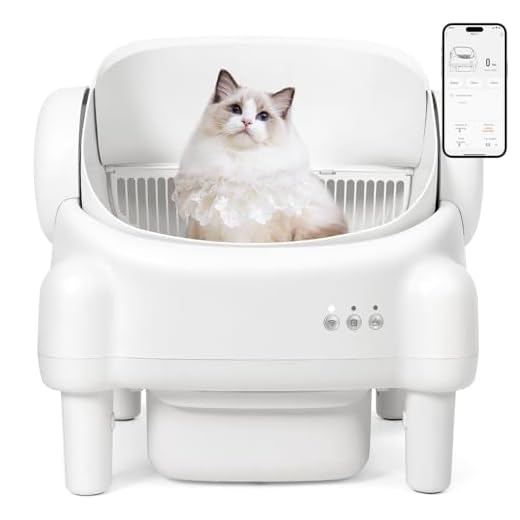A Nose-Friendly Welcome: Why Smart Litter Boxes Matter
Living with cats is joyful, but keeping the house smelling fresh can be a real challenge. Litter is practical, yet odors and frequent scooping make life less pleasant.
Smart self-cleaning litter boxes offer a tech-forward solution. They remove waste quickly, reduce odor, and save time—so you and your cat enjoy more clean air and less fuss.
This article explains the core technologies inside these devices, how sensors and software work together, and simple tips to maximize odor control at home.
Expect clear explanations, practical advice, and real-world troubleshooting tips for busy owners.




Best Self-Cleaning Litter Box: Neakasa Smart Cat Litter Box for Clean, Easy Pets
The Basics: What Makes a Litter Box "Smart
Core components, explained simply
A “smart” litter box combines everyday hardware with a little control brain. Think of it like a tiny appliance built around the cat’s bathroom:
Common product examples to illustrate: the Litter-Robot series uses a rotating globe to scoop, the PETKIT Pura X focuses on sealed waste cartridges and HEPA filtration, and CatGenie takes a different route by washing granules like a tiny washing machine.
What the smart design is trying to achieve
Most smart boxes aim for three simple goals:
Design choices map directly to those goals. A sealed chamber and a carbon filter lower nuisance smells in a busy kitchen. An enclosed tray keeps curious kids from getting into the litter. Automated sifting or a rotating scoop means waste is removed minutes or hours after use, not days later.
Quick, practical buying tips
Next up: we’ll open the box and dig into the sensors and mechanical tricks that actually find and remove the waste.
Finding and Removing Waste: Sensors and Mechanical Solutions
How the box “knows” a cat has been here
Smart boxes use a few sensor tricks to decide when to clean — and to make sure they don’t run while a cat is inside.
Real mechanisms that move the mess
Manufacturers pair sensors with physical systems that separate and transport waste into sealed bins.
Safety and fail-safes
To keep cats safe and comfortable, well-designed units include multiple protections:
Timing, speed, and odor control (practical tips)
Shorter gaps between use and removal mean fewer smells — but balance is key. Set a 5–10 minute delay so the cat finishes and leaves; avoid ultra-fast cycles that can scatter litter. Keep sensors clean, maintain correct litter depth (too little can confuse load cells), and test safety switches after setup. For multi-cat homes, increase bin capacity and consider models with faster throughput to avoid backlogs of waste.
Stopping Smells in Their Tracks: Active and Passive Odor-Control Technologies
Passive defenses: block first, filter second
The first line of defense is simply keeping odors trapped. Well-designed smart boxes use:
These passive measures are low-energy and silent. In practice, a snug gasket plus a fresh carbon filter will cut most “box smell” by a large margin — think of going from “room noticeable” to “you’d never know it was there.”
Active systems: move, neutralize, and sterilize
When blocking and filtering aren’t enough, active tech steps in:
How combos win — and what to watch for
The best results come from layering approaches: mechanical isolation (tight seals) + filtration (carbon or cartridge) + biological neutralizers (enzymes). That three-pronged setup tackles odor sources, airborne molecules, and the microbes that sustain smells.
Trade-offs to consider:
Quick tip: check gaskets, set fans to low for constant airflow, and drop a fresh enzyme packet in the drawer after a heavy-use day. Next up, we’ll peek under the hood to see how software and learning make these odor systems smarter and more convenient.
Brains Behind the Box: Software, Learning, and User Interaction
Embedded firmware: the invisible conductor
The litter box’s embedded firmware is the small, efficient software that runs motors, reads sensors, enforces safety interlocks, and decides when to kick off a clean cycle. Firmware updates (OTA — over the air) often improve cleaning timing, reduce false starts, and tighten safety limits. Tip: keep firmware current — manufacturers frequently ship fixes that reduce noise or improve sensor accuracy.
Apps, schedules, and learned routines
Smart apps turn a mechanical device into a context-aware one. Common features include:
Example: if Whiskers visits mostly around 7am and 8pm, the box can learn to run a cleanup 10–20 minutes after those peaks, removing fresh waste promptly without cycling every single time.
Notifications and status dashboards
Modern boxes push useful alerts so you don’t have to guess:
These keep mechanical filters and enzyme packs at peak effectiveness by prompting timely swaps.
Analytics that spot health issues early
Usage logs and weight sensors do double duty. Regular patterns are baseline health; sudden spikes in visits or a drop-off can indicate urinary issues — often the source of persistent odors. Actionable tip: review weekly usage charts; set thresholds for abnormal activity alerts so you can consult your vet before smells escalate.
User-configurable modes & manual control
Most apps offer simple toggles:
Practical how-to: enable learning mode for two weeks, set sensitivity to “medium,” then enable Quiet mode at night. Mute routine notifications but keep abnormal-activity alerts on.
Software reduces guesswork: it times cleans, prompts maintenance, and adapts to your household so mechanical seals, filters, and enzyme cartridges do their best work. Up next, we’ll move from smart settings to hands-on tricks and fixes you can use day-to-day.
Real-World Tips: Maximizing Odor Control and Troubleshooting
Smart placement = half the battle
Pick a spot with steady airflow (near a hallway or laundry room, not a closed bedroom). Aim for 3–6 feet from main living areas so smells don’t travel, and place the unit near an outlet. Avoid direct sun (it dries litter and can amplify odors) and a carpeted floor (easy to clean spills). A small anti-vibration mat under the box cuts noise and prevents motor rattles.
Match your litter to the machine
Not all litters behave the same in automated systems. Clumping clay works well with sifting boxes like Litter-Robot 4; crystal silica is great for passive odor adsorption in scoop-free models like PetSafe ScoopFree; washable granules only pair with systems designed for them (CatGenie S100).
If your box clogs or leaves residue, try a slightly larger clump size or a low-dust formula recommended by the manufacturer. Always check the manual for approved litter types.
Keep filters, bins, and cartridges timely
Set a simple schedule:
Pro tip: mark filter dates on your phone calendar or use the app reminders so replacements don’t slip.
Quick fixes for common hiccups
Troubleshooting lingering odors
Reduce noise and save energy
Use Quiet/Night or Eco modes, schedule cycles during the day, add rubber pads to dampen vibration, and consider a smart plug to power down nonessential times. Reduce cycle frequency cautiously—monitor for odor spikes.
Quick setup & care checklist
These practical steps turn smart features into reliable, everyday odor control — next, we’ll wrap up with the big-picture takeaways for a fresher home.
Fresh Home, Happy Cat: Wrapping Up
Smart litter boxes blend prompt waste removal, filtration, active neutralizers, and smart software to reduce odors while keeping cats comfortable. These systems work best when paired with good basics—scoop, litter choice, and regular maintenance.
Try small tweaks (different litter, location, or cycle settings) to see quick gains. Balance tech features with simple habits to find what fits your home. Make a change a week and notice how fresher your space and happier cat becomes.








Short: Paruuntys’ odor control actually felt legit in my studio apartment. The seals are tight and the charcoal module helped. Not a miracle, but less ‘litter stank’ especially at night. Would recommend for small spaces.
Good to know — I live in a studio too. Saving this for my next upgrade.
Studio owners: keep a window cracked or a purifier running too. Seals help but won’t catch everything.
Thanks for the firsthand tip, Zoe. Small-space performance is where sealed drawers + charcoal shine. Good to hear Paruuntys worked for you.
Small nitpick: the section on passive filters could’ve mentioned activated charcoal brands or refill costs. Otherwise, solid overview.
I’ve been swapping DIY charcoal sachets in my Smart Open to save money. Not as pretty but works decently.
Totally — filter costs add up. Paruuntys’ odor module was pricier for replacements when I checked last year.
Good point, Mark. We kept it high-level to avoid endorsing specific brands, but activated charcoal/zeolite filter lifespans vary — expect 1–3 months depending on usage. We’ll consider adding a short cost-comparison in an update.
Minor silly comment: my cat judges me every time the box cycles. She sits on the couch like ‘Really, again?’ 😂
Also, pro tip I learned: place a mat with ridges in front of the box to trap tracked litter. Makes the whole room smell fresher since less gets scattered around.
Love that visual! The mat tip is great — reducing tracked litter is underrated for odor control. Bonus: washable mats are a lifesaver.
My cat also gives me side-eye. Cats are drama kings/queens.
That mat trick saved my floors. Also vacuum around the box weekly to keep dust down.
Loved the breakdown on odor-control tech — especially the active vs passive part. Been eyeing the Fumoi 95L because of the app controls, but worried about noise and whether my shy cat will use it.
Anyone here tried Fumoi or the KITPLUS? Do cats ever get spooked by the self-clean cycle? Also, pro tip request: best way to introduce a smart box to a cat that’s used to a basic tray?
I have a timid cat and used that exact approach. Also, try putting some of the old litter in the new box so it smells familiar. Fumoi was okay for us — a low hum, not a scary robot apocalypse sound 😂
I’ve had my KITPLUS for 6 months and the cleaning is almost whisper-quiet. My cat ignored it at first but now treats it like any other box. Patience and snacks helped.
Great question, Sarah — thanks for reading! Many cats are fine if you introduce the new box gradually: place it next to the old one for a week, let the cat explore while the unit is off, and run a few short cleaning cycles when they’re not nearby. Fumoi tends to be quieter than older models, but every cat is different. KITPLUS has a simpler mechanical action that can be less startling for nervous kitties.
Nice article! The sensor section answered why my previous ‘smart’ box left clumps behind — apparently the sensor placement matters a ton. Also lol at the ‘Brains Behind the Box’ — AI for litter, who knew? 😄
Yeah sensors can be garbage if they’re aimed wrong. Some models use weight sensors on the platform, others use IR. Weight sensors are better if your cat tends to dig a lot.
Interesting — do any of these have multi-cat support? My two cats have different weights and schedules.
Cegimus app-controlled box uses a weight-sensing tray in my place and I haven’t had missed waste in months. Not cheap, but very reliable.
Glad that section helped! We tried to explain tradeoffs: IR sensors detect movement well, but weight or pressure mats can be more reliable for heavy diggers. Product design and calibration matter as much as tech.
Okay rant incoming (long read):
I bought a self-cleaning box years ago and it was a nightmare — jammed constantly, litter everywhere, and the app was flaky. This article convinced me to maybe try again because of better sensors and ‘learning’ features.
But I’m skeptical. If a product like the Paruuntys or Smart Open claims ‘odor control’, what’s realistically happening? Is it just sealed drawer + charcoal or actual filters and PCO/ionizers? I’m allergic so I need something that actually reduces ammonia levels, not just masks it.
Any real-world experiences from allergy sufferers would help. Also — anyone tried combining a smart box with a small HEPA room purifier? Worth it?
Agree with admin — don’t trust ionizers alone. HEPA + carbon is the safest combo for allergies.
I’m allergic too. Using a Fumoi plus a HEPA purifier made a noticeable difference in the litter room. Less throat irritation in the mornings.
Thanks for the thorough comment, Emily. Short answer: many units rely on sealed waste compartments plus activated carbon/zeolite filters — those reduce odors but don’t eliminate ammonia completely. A few higher-end models (and add-on modules) include ionizers or catalytic PCO, but effectiveness varies and ionizers can create byproducts some people dislike.
If you have allergies, pairing the box with a small HEPA + activated carbon purifier for the room is a practical approach. That combo helps particulates, dander, and some VOCs/ammonia.
I’ve got the Paruuntys and it uses a charcoal module plus strong seals. Better than nothing, but I still run a purifier. Also keep the box cleaned regularly — no tech replaces basic maintenance.
Short and sweet: the Smart Open (self-cleaning) seems like a good budget pick. The article’s comparison of sensors vs mechanical scoops helped me decide what to look for. Curious — does anyone find app alerts annoying? I don’t want a million pings every day.
You can usually control notification frequency in the app settings. I get weekly summaries and only immediate alerts for errors — works well.
Right — most of the listed models (Cegimus, Fumoi, Paruuntys) let you toggle types of notifications. If you want minimal noise, set only critical alerts (jam, full bin).
I turned off all but the “waste drawer full” alert. No daily pings and still peace of mind.
Constructive note: battery/backup power wasn’t discussed. Power outages in my area happen — does anyone know if the Cegimus or Fumoi have battery backups or manual clean modes? I don’t want a full bin and no way to clear it after a storm.
Good practical point. Most app-controlled boxes don’t have built-in battery backups, but some offer manual override cycles or removable waste trays you can empty by hand. Fumoi and Cegimus typically allow manual maintenance; check specs for emergency power options.
My Fumoi has a manual pull-out drawer so you’re fine during outages. But the motor features obviously won’t run.
I keep a collapsible scoop for emergencies — low-tech but lifesaving 😂
Funny thought: robots cleaning litter while we Netflix — peak 21st century. On a more practical note: how eco-friendly are these devices? The article touched on filter replacements but not landfill impact of single-use cartridges. Anyone looked into sustainable options?
Nice perspective. Sustainability is an emerging concern: replaceable cartridges and non-recyclable parts are an issue. Some owners use reusable charcoal pouches or buy bulk filters to cut packaging waste. We’re looking into a future piece focused on eco options and longer-lived components.
I reuse activated charcoal in cloth bags and rebake it to refresh a bit. Not perfect but reduces waste.
Some brands ship recyclable cartridges but they’re rare. Worth asking sellers about materials before buying.
Has anyone tried the Smart Open vs KITPLUS side-by-side? I’m torn between a basic open self-cleaning or a larger unit like KITPLUS for my big Maine Coon. Concerns: capacity, robustness, and availability of replacement parts.
KITPLUS has been solid for my big cat. Smart Open felt cramped. Parts were available online when I needed them.
Size matters — my big boy avoided smaller boxes. Go large if you can.
For a Maine Coon, I’d lean toward a larger model like KITPLUS or Fumoi 95L. Bigger trays and sturdier mechanisms handle large cats better. Also check manufacturer support and part availability — some brands sell replacement sieves and motors separately.
I appreciated the troubleshooting checklist — wish I’d seen it before buying. Minor gripe: there could’ve been more photos of internal parts (sensors, trap, filters) to identify issues quicker. Anyone else want visual diagrams added?
Thanks, Olivia — good feedback. Visuals are a great idea, we’ll consider adding labeled diagrams in the next revision to help with DIY fixes and part ID.
Yes please. I had to disassemble mine blind and didn’t know what the ‘mystery spring’ did 😂
Diagrams would save so much time (and broken clips).
Heard good things about the Cegimus App-Controlled box. Does the app actually learn litter patterns or is that marketing speak? Curious if it adapts to different cat schedules.
Cegimus and a few others have basic learning: they track usage times and can avoid running cycles during peak times or learn to delay cleans after short visits. It’s not deep ML, but it reduces false cycles by observing patterns.
Marketing sometimes overstates ‘learning’, but it’s useful for personalization. Don’t expect it to predict every odd behavior tho.
My Cegimus learned to wait until after midnight when my cat tends to roam. Pretty handy and cuts down unnecessary noise.
Neutral take: smart boxes are neat but not a substitute for scooping in multi-cat households with heavy use. The article’s ‘Real-World Tips’ nailed that. Also, check compatibility with litter brand — many are picky.
I have 3 cats and still scoop daily, but the smart box reduced the mess and helped with smell between full cleans.
Exactly — capacity and cycle frequency matter a lot with multiple cats. Some models (like large Fumoi 95L or KITPLUS Large) are better suited to multi-cat homes, but even then maintenance increases.
Same here. It cuts down daily labor but doesn’t fully remove the need for attention.
Question for real-world troubleshooters: what’s the most common mechanical failure you saw? Mine jammed because of clumpy litter getting stuck in the chute — now I use a lower-clump formula and it helped.
Yep, keep the waste drawer under its max fill line. Some models have a removable sieve that needs cleaning monthly.
I had a motor strain because the drawer was overstuffed — empty more often fixed it. Also, don’t use pellets meant for ferrets 😂
Good troubleshooting topic. Top issues we hear: clumping litter causing jams, dust buildup on sensors, and bin-full sensors misreading because of stuck litter. Regular brushing of chutes, using recommended litter types, and an occasional sensor wipe usually prevent most issues.
This line made me laugh: ‘Fresh Home, Happy Cat’ — honestly true though. My cat stopped peeing outside the box once I upgraded because the smell was gone and the box was cleaner. Also, tip: set the cleaning timer to run while you’re at work so cats don’t watch it.
I do that and also lower the cleaning speed to be gentler. Cats notice details!
Happy to hear it worked for you, Hannah! Scheduling cycles while you’re out is a good idea — comfort and privacy help with acceptance.